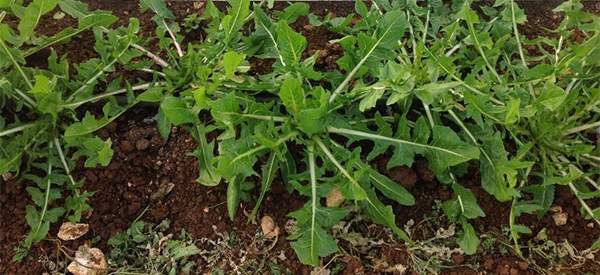
If You See This Plant in Your Backyard, Don’t Step on It
Every gardener has had that moment when you come across a new plant that has sprung up from seemingly nowhere, and you’re not sure whether to pull out the suspected weed while it’s still at a manageable stage or nurture it as a welcome addition to your backyard.
Chicory (Cichorium intybus) is one of these plants that many people assume is a weed, but in fact, is one of the many herbs that are valued for its therapeutic and medicinal properties.
The bright blue flowers of chicory look fantastic in the garden, and it’s definitely a worthy herb to have on hand. It has numerous medicinal uses, it brings out the flavor of coffee, it makes a good livestock feed, it is used to make colorfast dyes and it’s a popular culinary herb.
How to Identify It
The bright blue flowers are the easiest way to identify chicory. The tips of the petals are toothed, which makes it look a little bit like a blue dandelion. It even has a similar number of petals – around 20. The flowers open early in the morning and close again by lunchtime.
When it first emerges, the leaves form a flat rosette, just like a dandelion, however, it has a much taller, tougher stem (up to 3 feet), which is multibranched, hairy, and holds several flowers, along with a few small leaves. It can also be distinguished by the white milky sap from the stems and leaves.
This perennial herb has a thin taproot, which allows it to re-shoot rapidly. You may stumble across this herb growing in your garden as a result of ants collecting and moving its seed around, but unlike dandelions, it doesn’t use wind as a means of seed dispersal.
Harvesting Instructions
Harvesting chicory is a matter of cutting the tall stems a few inches above the ground with a pair of pruning shears, and leaving the taproot to re-sprout and produce more flowers. You can usually get a second harvest from them, and in a good year, three. This is one reason why chicory is suitable for making fresh fodder for animals. It’s a great idea to get a foraging book to reference. We recommend The Forager’s Guide to Wild Foods.
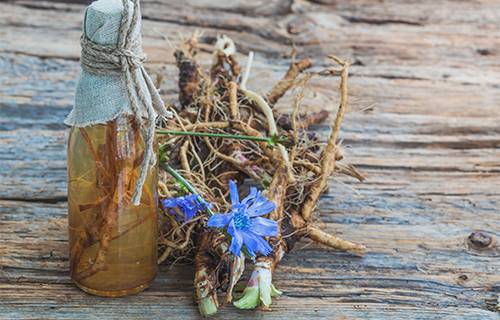
The root typically has a higher concentration of some of the medicinal compounds, and it is possible to dig up half the taproot, and the remaining half might still re-shoot and regenerate.
Historical Medicinal Uses
Chicory has been used medicinally across Europe since the Middle Ages. During the renaissance period, it was thought that the healing power of a plant was based on what it looked like. For example, because chicory has a milky, white sap, this apparently meant it could increase or decrease the amount of breast milk produced by mothers; its closed flowers meant it could treat infected eyes; bruises could be treated with its bruised leaves, and so on.
⇒ Add Chicory to Your Backyard, Last 30 Packs Left!
Suffice to say, that this method of assigning medicinal qualities based on observed physical traits was generally inaccurate (although quite amusing and interesting now). Some cultures claimed that it could make you invisible.
On the other hand, it was accurately touted as a ‘friend of the liver’ back in 200 A.D and has been made into a popular liver tonic ever since then. People suffering from toothache were made to chew on the bitter leaves or roots to alleviate the pain and swelling.
Modern Medicinal Uses
Luckily, modern studies have investigated the medicinal value of chicory. Just like many other plants, the bitter taste of chicory has been found to increase the amount of bile produced by the liver, and therefore, it can aid digestion, and possibly treat kidney stones, gallstones, and various other liver ailments (so it really is a ‘friend of the liver).
The white sap found throughout the whole plant contains lactucarium. This is a similar compound to opium, but much milder and safer. It’s lactucarium that gives chicory its mild sedative and anti-inflammatory properties, and which provides pain relief. It has been found to be as effective as other non-steroidal anti-inflammatory drugs, such as Ibuprofen painkillers. Studies have also found the roots to be high in antioxidants and have strong anti-bacterial properties. Chicory roots can also decrease blood pressure by expanding blood vessel walls. As a diuretic, it stimulates the production of urine, which therefore assists the kidneys to remove toxins and excess fluids. This increase in urination leads to the removal of uric acid and excess fluids, which can subsequently treat arthritis, gout, and urinary tract infections.
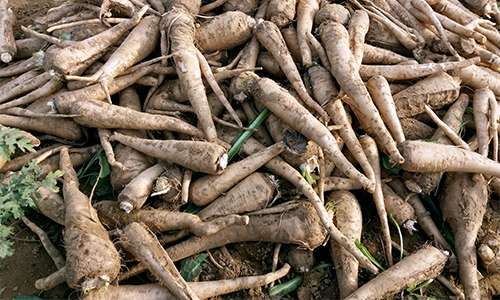
Chicory can reduce the severity of allergic reactions by inhibiting the production of histamines.
Although quite small, chicory root is a surprising source of fiber. It consists of 16% inulin, which is a soluble type of fiber that is associated with improving the health of the entire intestinal tract, as well as responsible for producing a mild laxative and sedative effect. It is surprisingly common in gluten-free and high fiber products, and when processed, inulin takes on a slightly sweet taste which can also be used as a natural sweetener.
Research has also identified some compounds in chicory that can kill the malaria parasite and mosquito larvae.
How to Use Chicory as Medicine
The easiest way to use chicory is to ingest it. The leaves add flavor to a salad, and both the leaves and roots make a nice addition to pickling recipes, and go well in a roast, although some of the compounds and nutrients degrade when cooked.
A poultice can be made quickly by crushing or grinding a fresh plant and binding it to any sore joints or muscles. Or you can prepare a tincture or salve to have on hand in the medicine draw at home to massage into tired, aching muscles.
Having some dried chicory tucked away in a cupboard means you can brew some chicory tea anytime. The tea should be brewed for at least 5 minutes. Otherwise, you can grind up roasted roots to either add to your coffee or to substitute your coffee for a caffeine-free drink.
Something You Must Know
Studies have shown chicory to be reasonably effective at decreasing blood sugar levels, so people with diabetes need to be cautious when ingesting this herb.
Since this is yet another plant from the daisy family (Asteraceae), then anyone who is allergic to ragwort, daisies, or marigolds should avoid growing, handling, or consuming chicory.
Chicory can stimulate the uterus and cause miscarriage, so shouldn’t be eaten when pregnant.
The white sap of chicory can irritate people with very sensitive skin, but most people don’t have any issues handling it.
So, if you see chicory sprouting in your backyard, don’t be too hasty to rip it out and throw it in the compost pile with the rest of the weeds. It could turn out to be your next medicine, meal, drink, animal feed, or dye.
You may also like:
 I Used To Cut This Plant Until I Saw This!
I Used To Cut This Plant Until I Saw This!
The SHTF Medicinal Garden You Should Have in Your Backyard (Video)
9 Natural Remedies that People with Diabetes Will Find Useful

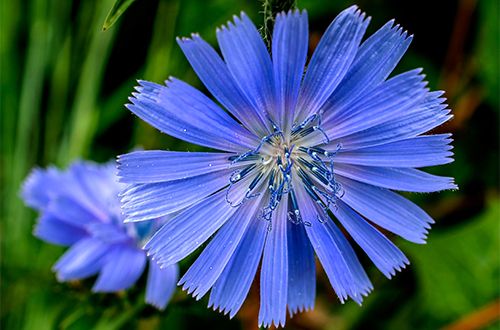
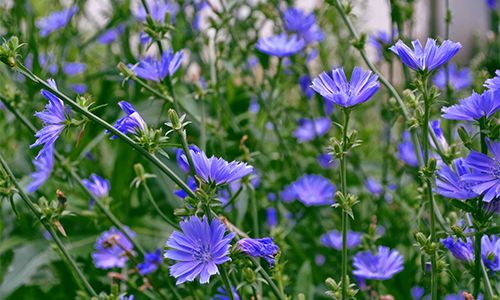
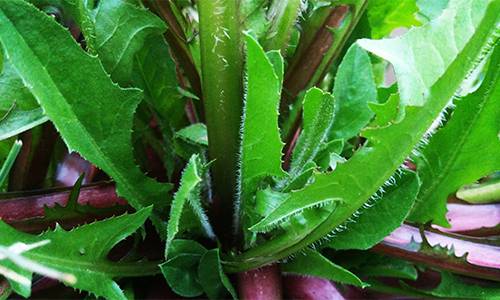
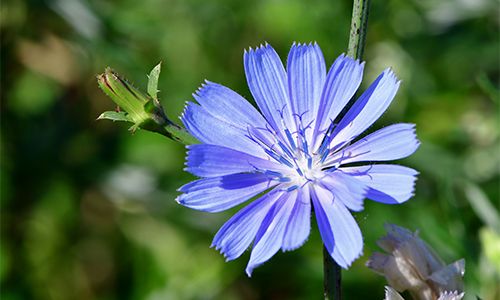
Could you please tell me if chicory is the same plant that we call bachelors button in the East?
We have this growing wild here on the West coast. We call it Bachelor Button (AKA Chicory) I would like to know if this is the same also
Yes it is
There is an app called PictureThis. I use it to help identify plants.
No. Bachelor Button and Chicory are two different plants.
Really love this article about chicory!
Yes its the same
We have a large Bush like trees in our garden, it has a very strong smell, Yes we do get fruit on them, but very small, I was told, it is a FIG trees!, I was wondering if one can use the leaves for any thing like a Herble machine, When one back’s a leaf off of the stem, there’s a White Cream runs out of the stem?
No, it is not. Please do not make this mistake.
If you Google them both you will find that they belong to different species.
No, bachelor’s buttons is a Centaurea species and chicory is Cicorium. Chicory is perennial and BB is annual. Chicory has blue and occasionally white flowers; BB has blue, rose and white colored blossoms.
I have chicory growing wild along my country road and at the end of my driveway. Do you know how I can get seeds or otherwise propagate this. I like to put it in my garden.
no it is not the same , i am a beekeeper and know a little bit about some flowering plants
No it is a different plant.
No it is not the same plant.
bachelors buttons latin name is Centaurea cyanus chicory root latin name is Cichorium intybus clearly different plants altogether.
I also live in the eastern US. There’s a pretty weed that grows along the roadsides which I’ve always called Bachelor’s Buttons. Apparently, I was wrong. After looking up BB, that is not what it growing beside the road. I’ll have to look more closely, but I suspect the roadside wildflowers are indeed chicory.
Although it does have similar physical qualities it’s a different plant. (I grow both). Chickiry us often found on the roadside or in feral fields. Closing its flower around noon you’ll only notice it’s blooms in the morning.
Yes. Sometimes. In NC both called BB. Common names delimma
No, they are completely different. Just because they are blue does not mean they are the same thing. Bachelor buttons are also known as cornflowers and they are an annual. Chicory is a perennial. Completely different.
There are many different kinds of Chirocy do they have the same properties
Palla Ross’s
Organic chicory Sugarloaf
Giant Chioggia
Chicory Fancey
Chicory and Batchelor Button are two different plants.
No it is not
I buy Bachelor’s Buttons seeds to plant in my flower beds every spring. We also call it Ragged Robin here in WV. Chicory is not the same thing as these Bachelor’s Buttons…you can go to a seed catalog and look up Bachelor’s Buttons among the annuals, to make a better identification. Chicory grows wild along our roadways and in our yards, etc. It is entirely different, in this part of the country at least. I hope this helps…..
Chicory is also called blue daisy, blue sailor, wild bachelor’s button, blue or Italian dandelion, or even coffeeweed, to list just a few of its many names.
Excellent info.
Hi Rich,
Thank you for your feedback. I really appreciate it.
God bless!
Would appreciate including where it’s grown. I’m in central Texas, super SUPER hot in the summers. Does it grow everywhere, i.e. shade? full sun? wooded areas? thanks so much for all this good info.
It grows mostly in full sun! It loves the side of the road usually in a graveled area.
I’ve spent most of my life in different parts of Texas and never saw a chicory plant until I went to Wisconsin, where they grow wild on the roadside.
They are quite lovely.
I’m going out to harvest some natural herbs. I live in NW IL. If I can find enough, I could send you some Chickory. PM me if this is of any interest to you. I harvest a lot of natural things and am totally out of ev err anything. But, I’m going to be out gathering very soon.
I found an article full of information on how to distinguish chicory. By Janet Hardy.
“Bachelor’s button, which is also called cornflower, is Centaurea cyanus. Another blue-flowered plant called cornflower is Cichorium intybus, which is also called chicory. To further confuse the matter, the common name “chicory” also is used for curly endive (Cichorium endivia).”
Sachelle is correct: botanically, bachelor’s button and true chicory are NOT the same plant. This is why horticulturalists use the Latin names and not the common names of plants. Centarea flowers have pointed petal tips, not toothed, and the stems are thinner and smooth. Here’s a pic of Centaurea (bachelor’s button) flowers. https://encrypted-tbn0.gstatic.com/images?q=tbn:ANd9GcQe3iMXR-oRh-1LtGwAJ0IHSloWJRHWnoLc0i5kHoMxoA&s
thanks for clarifying that. I have been calling something else ‘Bachelor’s buttons’, not this one. I have never seen this one in my life! wish I had it. Is this called ‘wild lettuce’ sometimes?
Not the same. Wild lettuce has a prickly stemm and leaves that are more pointed. If you break the stem of wild lettuce, it has a milky substance inside. My neighbors don’t like that I don’t pull this ‘weed’.☺️
Thank you for including the photo of Bachelor Buttons – very helpful to distinguish them from Chicory.
What areas of the country would have this
Hi Jim,
Thank you so much for your comment.
Chicory, (Cichorium intybus), blue-flowered perennial plant of the family Asteraceae. Native to Europe and introduced into the United States late in the 19th century, chicory is cultivated extensively in the Netherlands, Belgium, France, and Germany and to some extent in North America.
God bless!
I have tons of chicory growing on the berm of the road. It is so pretty when the plant opens. It is considered a problematic weed here in the manicured poison laded lawns!
I live in northeastern Ohio.
My radicchio, endive and escarole are all blooming with those gorgeous flowers. Do their roots have any medicinal properties?
Hi Lutvija,
Thank you so much for your comment.
Chicory root is a good source of inulin, a type of prebiotic fiber that has been linked to increased weight loss and improved gut health. It also contains some manganese and vitamin B6, two nutrients tied to brain health.
God bless!
Do you have any to mail to me.
Hi Florestine,
Thank you for your comment.
Please check your email address. We have sent you an email regarding your order.
God bless!
Thank you for this! I’ve gathered the leaves in the spring thinking they were dandelions – until it bloomed. Then I started digging them out. I won’t do that anymore. ☺️
It is said that weeds are plants with a bad reputation. Time to change that!
Thank you for letting know about this medicinal plant Chicory. I have too many health problems. Is it possible to communicate with Nicole, whose book we just bought. Also Is there any way we can get the medicines made from these plants.
Will be grateful if you would respond. Thanks a billion
George
Do you crush the leaves, or both the leaves and the flower? Do you wait til it dries? I want to use as a tea for back pain/inflammation and to lower blood pressure.
Hi Shukria,
Chicory tea is prepared by steeping one-ounce of dried chicory root in a pint of boiling water for 10 minutes.
As soon as possible after harvesting, you can prepare the chicory root for drying.
Rinse all the soil off the roots and either grind them or, just chop them into tiny pieces with a knife. The smaller the pieces the better.
Roasting the root is what brings out the nutty flavor so throw those pieces in the oven for an hour and a half at 350 F, or until the root looks nice and dark.
The beverage is very bitter on its own, so you may want to mix it with sugar or honey.
God bless!
What a bummer it’s in the Daisy family. I’ve learned that I’m allergic to this family of plants and react to any tincture, supplement, etc that includes them. Many helpful “multi” supplements contain plants from the Asteracae family, so sad for me. I wish somethings would help tone down my allergies to them so I could utilize them as well.
Research nettle tea – it might be an option
GOD BLES YOU MANY TIMES OVER-!!!
THAT’s ALL FOR NOW. NOTHING MORE. NOTHING LESS. THAT’s ALL.
SINCERELY YOURS, JOHN
I am new at this but am thinking of studying more about it. What books should I read?
Hi Eva,
Thank you for your interest in our work.
You’ll find 800+ beneficial plants and remedies in “The Lost Book of Herbal Remedies” – recipes of tinctures, teas, decoctions, essential oils, syrups, salves, poultices, infusions and many other natural remedies that our grandparents used for centuries. What’s also special about this book is that it has between 2 and 4 high definition, color pictures for each plant and detailed identification guidelines to make sure you’ve got the right plant.
You’ll also find a Medicinal Reference Guide inside where you can look up an ailment and see what herbs are used for it (and what page they are on). Plus, it has a very thorough appendix, making it easy for you to find any plant or ailment you’re interested in.
God bless!
Hello, I purchased the lost herbs book but can’t figure out how to find my digital copy. Any help is appreciated. I am also wanting to purchase other books from a recent email I received from you but I am afraid to until I figure out how to get them once purchased.
Thank you looking forward to hearing from you and being able to access the book and purchase the others.
Respectfully,
JoDean
Hi JoDean,
Thank you for your interest in our work.
I apologize for the difficulties you encountered regarding the digital book download process.
Please check your personal email for a message I just sent now with the download link.
Many blessings and good health!
Can these plants be Transplanted?
Thanks
I’m so looking forward to the content for pain ‘any pain killers’
Thanks
Nancy 🌺
I have this every year, but white to yellow flowers. Looks like a huge dandelion or weed. I mean huge, like 6 feet. The comments have left me more confused. Mine definitely not blue.
Sounds like you might have wild Lettuce or Prickly Lettuce. It also has the white oozing medicinal latex like the Chicory. I dry the leaves of the wild lettuce to make a tea and use like ibuprofen. Google Wild Lettuce
That is not chickory
Using raw honey from areas where these types of plants are prevalent can greatly reduce allergic sensitivity to these specific types of plants. It somehow causes a reduction in the immune response to the plants whose pollen and nectar were used in the making of the honey. I hope it works for you. Strained honey is fine, but it must be raw.
Im in Switzerland. Is it growing here?
Probably, Anja! They actually cultivate chicory in Europe in The Netherlands, Belgium, France, and Germany. We in the US didn’t even have chicory until European settlers brought it here. Now it is everywhere, LOL. If you don’t find it wild you should have no problem finding plants or seeds.
Are all the photos within this column the plant being discussed?
THIS WEBSITE SUCKS! THE HEADER TAKES UP HALF OF MY WINDOW! I CAN’T GET THE WHOLE PICTURE IN VIEW! HOW AM I SUPPOSED TO IDENTIFY A PLANT IF I CAN’T EVEN SEE THE WHOLE PANT AT ONCE?
Shame on you. I am having no problem. Obviously it’s your computer monitor.
I’m on a tablet and don’t have the problem your having. Fairly sure it’s not the website.
Thanks
I’m pretty sure we don’t have this one in Australia?
Yes we do im in WA and it grows like a weed here
I got the plant in bunnings in the herb section but you could get seeds from on line from All rare herbs
Like some others I’m having difficulties finding my digital copy and also the several other books I also paid for . Could you possibly assist a silly old fellow who struggles on tablets, your book arrived promptly, thank you.
My Dad always said the chicory roots were dried and ground up for “coffee” during the depression, is this correct? I’ve often seen cans of chicory in the coffee isle at grocery stores. Was it added to coffee grounds to make the coffee go further? This article refers to a “tea” drink which is 180 degrees from coffee? Please clarify it’s usage!
What part of the US does it grow? Living in SW part of USA. Where would it most likely grow? Also is there a regional guide or resource for herbs that are common to my area?
Thank you for the informtion. I have had this plant in my herb argen for a couple of years and had no idea what to do with it. I love the blue flowers .
I will begin to put it to good use.
Thx again
Can I purchase an actual book not just the web edition
No Chicory is not the same as bachelor buttons. Always check the Latin names. No relation.
Something for me to BOLO for!
Thanks!
Great info. Just waiting for my book
Pretty sure that the picture on the top of your article is not chicory. It looks like dandelion. The blue flower shown later is chicory. This could be confusing for some people.
Cichorium intybus L. Is chicory. Centaurea cyanus is bachelors button so two different plants